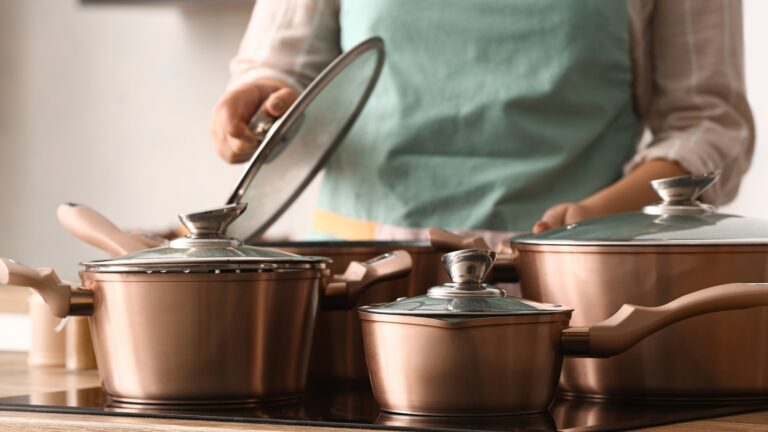Saucepans and pots are essential cookware in most kitchens, each serving distinct purposes. While they may appear similar, they have unique characteristics that make them suitable for different cooking tasks.
Understanding the differences between saucepans and pots, including their size, shape, intended uses, cooking methods, versatility, and cleaning and maintenance requirements, can help home chefs make informed decisions about which cookware to use for specific recipes and culinary needs.
In this guide, we’ll explore the difference between saucepans and pots to shed light on their roles in the kitchen.
Saucepan Vs Pot (Size And Shape)

Saucepan
Saucepans typically have straight sides and a flat bottom. They often come with a long handle and a lid. They are available in various sizes, ranging from 1 quart to 4 quarts.
The smaller sizes are ideal for heating sauces and making smaller quantities of food, while the larger ones can be used for cooking grains, boiling vegetables, and making soups.
Pot
Pots can have straight or sloped sides and come in various sizes, ranging from 4 quarts to 12 quarts or more. They typically have two handles and a lid.
Pots are versatile and can be used for boiling pasta, making stews and soups, and cooking larger quantities of food. The larger size and shape of pots make them suitable for cooking for a group or making larger batches of food.
Read Also:
Intended Use of Saucepan Vs Pot
Saucepans are more compact and come equipped with a long handle, this makes them perfect for preparing sauces, warming up liquids, and cooking smaller food portions. Then again, small pots, often referred to as pasta pots, are a bit larger and are specifically crafted for boiling pasta or preparing more substantial quantities of soups and stews
Saucepan:
Intended for heating or cooking smaller quantities of food such as sauces, gravies, boiling eggs, or reheating leftovers. Its smaller size and capacity make it suitable for these purposes.
Pot:
Intended for cooking larger quantities of food such as soups, stews, pasta, boiling potatoes, or making stocks. Its larger size and capacity make it suitable for these purposes.
Saucepan Vs Pot Cooking Methods
Saucepan:
Saucepans are suitable for cooking methods such as simmering, boiling, and heating. They are ideal for recipes that require liquids, such as sauces, soups, and boiling vegetables.
Pot:
Pots are versatile and can be used for a wide range of cooking methods, including boiling, simmering, steaming, and deep-frying.
They are suitable for cooking larger quantities of food and are used for making stews, soups, pasta, and one-pot meals.
The Versatility of Saucepan Vs Pot
Saucepan:
Saucepans are versatile for heating or cooking smaller quantities of food, such as sauces, gravies, boiling eggs, or reheating leftovers.
They are well suited for recipes that require liquids and are ideal for tasks like melting butter or chocolate, making oatmeal, or heating canned soups.
Pot:
Pots are versatile and can be used for a wide range of cooking methods and for preparing larger quantities of food.
They are suitable for making stews, soups, boiling pasta, steaming vegetables, deep-frying, and preparing one-pot meals.
Their larger size and capacity make them suitable for cooking for a group or making larger batches of food.
Cleaning And Maintenance (Saucepan Vs Pot)
Saucepan:
Saucepans are generally easier to clean due to their smaller size and shape. They are often dishwasher safe, but hand washing with a mild detergent is also convenient.
Stainless steel, non-stick, and enamel-coated saucepans are easy to maintain, and it’s important to avoid using abrasive cleaners or metal utensils to preserve their condition.
Pot:
Pots, especially those with larger capacities, can be more challenging to clean, especially if food particles get stuck to the bottom or sides.
However, many pots are dishwasher safe, and hand washing with a non-abrasive sponge and mild detergent is typically sufficient.
It’s important to follow specific care instructions for materials like stainless steel, non-stick, or enamel-coated pots to maintain their quality.
Tips
Here are some tips to consider when comparing saucepans and pots:
1. Size and Shape: Take note of the differences in size and shape between saucepans and pots. Saucepans typically have straight sides and a flat bottom, while pots can have straight or sloped sides.
2. Intended Use: Understand the intended uses of each cookware. Saucepans are ideal for heating or cooking smaller quantities of food, while pots are suitable for cooking larger quantities.
3. Cooking Methods: Consider the cooking methods each cookware is best suited for. Saucepans are great for simmering, boiling, and heating, while pots are versatile and can be used for boiling, simmering, steaming, and deep-frying.
4. Versatility: Think about the versatility of each cookware. Saucepans are suitable for different tasks such as melting butter, making oatmeal, or heating canned soups, while pots are used for making stews, soups, boiling pasta, and preparing one-pot meals.
5. Cleaning and Maintenance: Take into account, the cleaning and maintenance requirements of saucepans and pots. Saucepans are generally easier to clean due to their smaller size and shape, while pots, especially those with larger capacities, can be more challenging to clean.
Conclusion
The comparison between saucepans and pots reveals that while they may share some similarities, such as their ability to handle different cooking tasks, they each have distinct characteristics that make them suitable for different purposes.
Understanding the differences in size, shape, intended uses, cooking methods, versatility, and cleaning and maintenance can empower cooks to make informed decisions about which cookware to use based on their specific culinary needs.
Whether it’s the precise heating capabilities of a saucepan or the larger capacity and versatility of a pot, both pieces of cookware play vital roles in the kitchen and contribute to delicious and diverse meals.
By grasping the unique attributes of saucepans and pots, individuals can elevate their cooking experiences and achieve optimal results in the kitchen. So what do you prefer, saucepan or pot? lets know your thoughts in the comment section.



